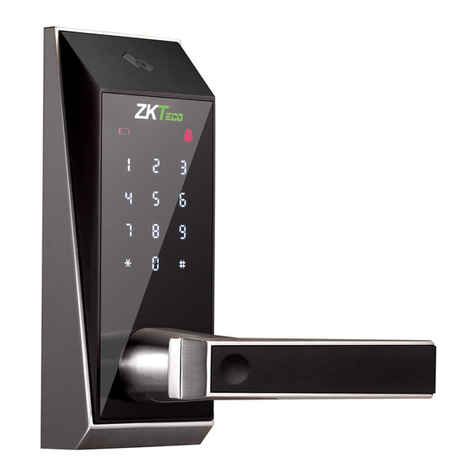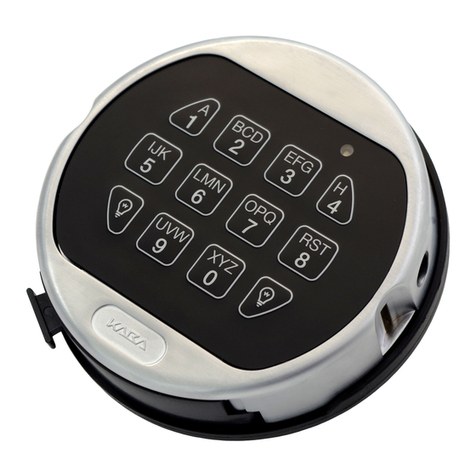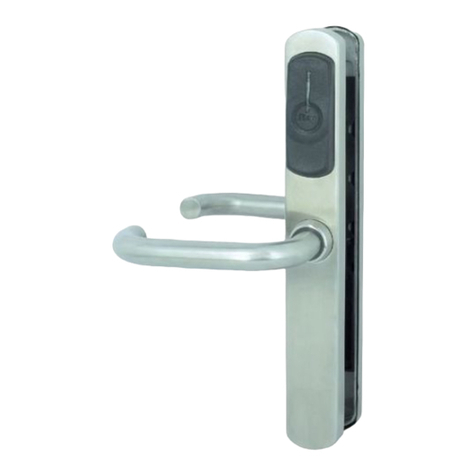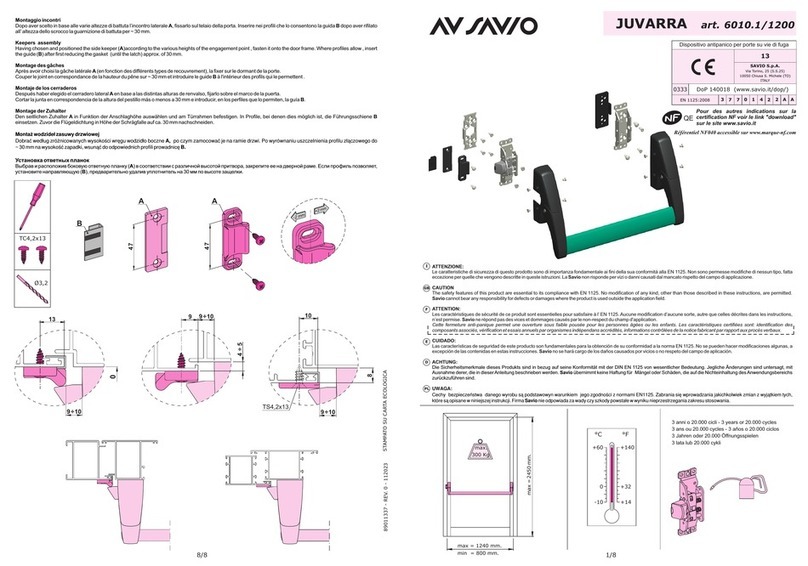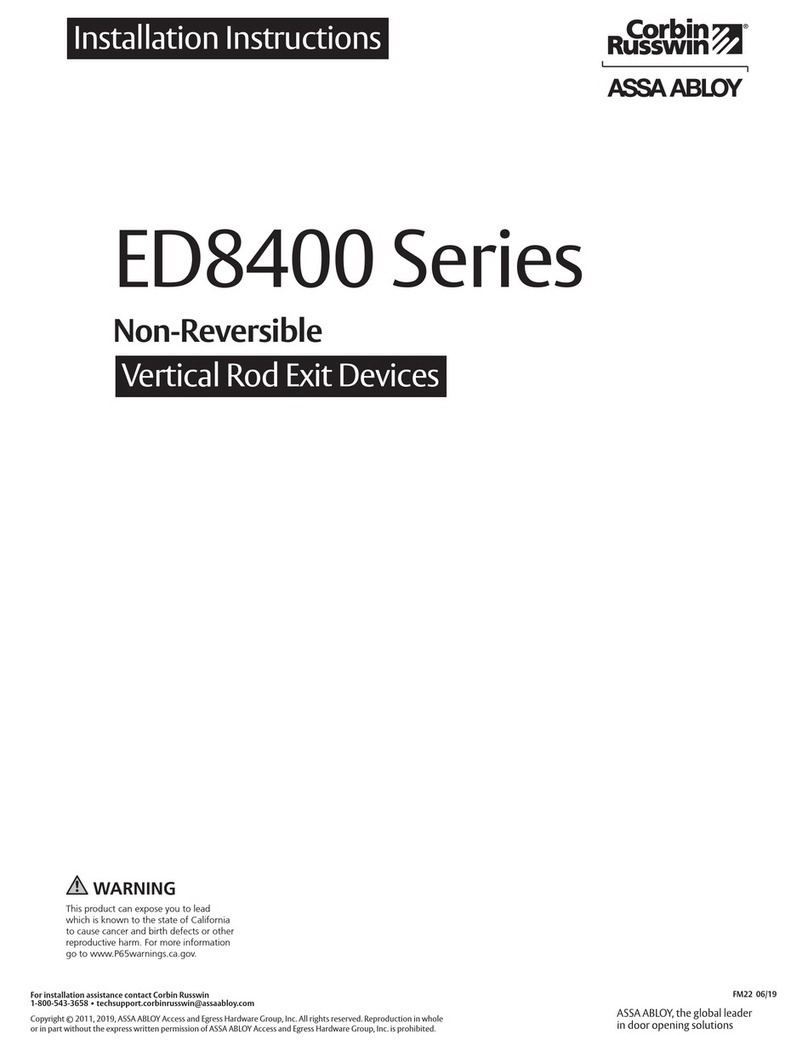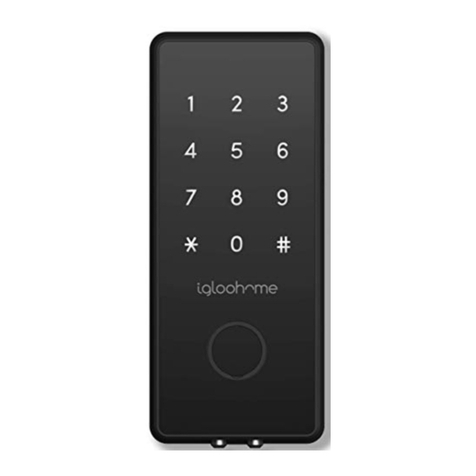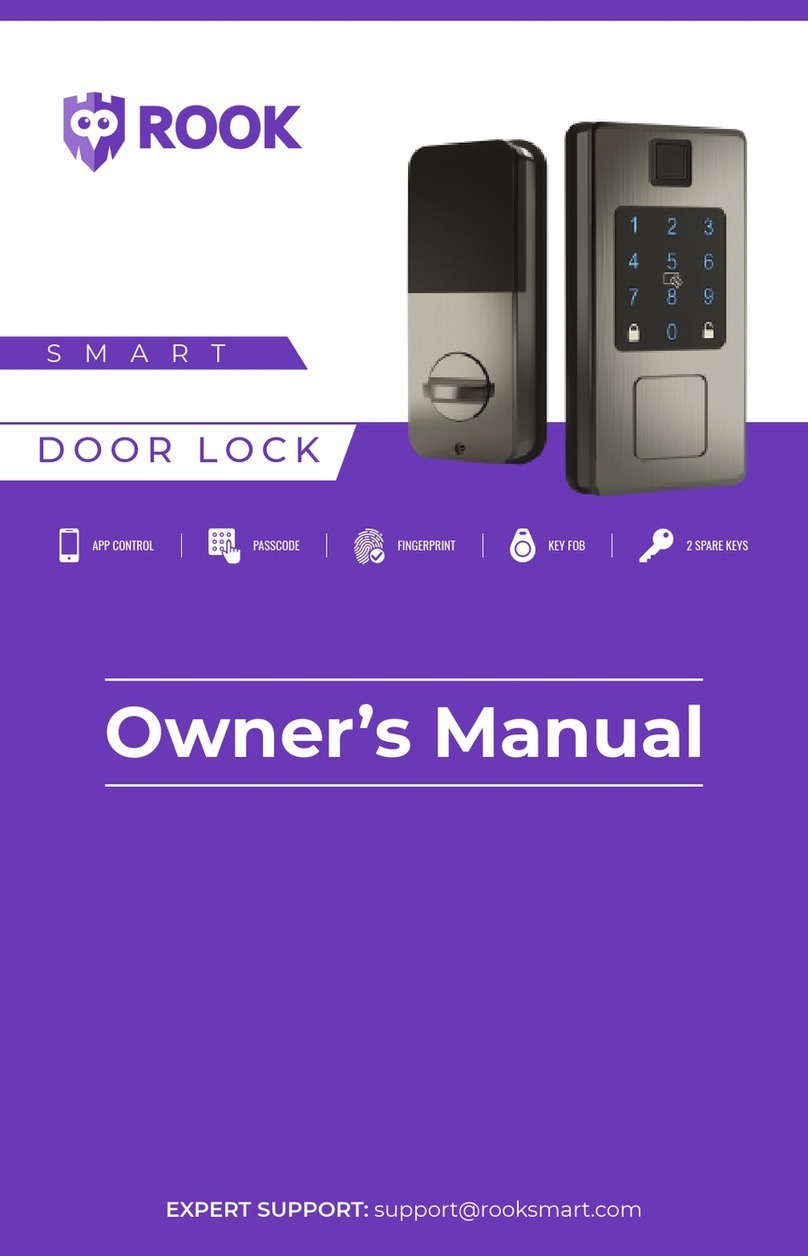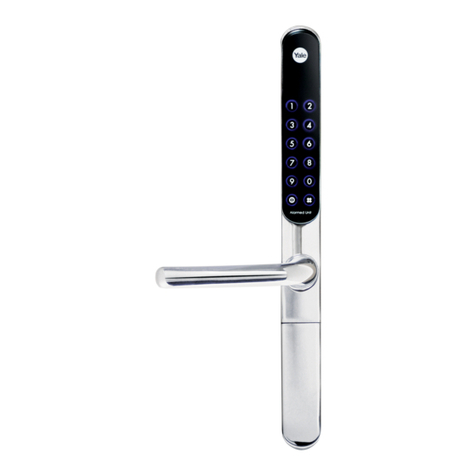Borglocks MK5 Series User manual

BL6000
MK5 Series Instruction
Manual
Helpline: +44 (0) 1708 225700
Problem Solving Guide
Maintenance: No maintenance of the internal parts should be necessary. If the lock is being used on an
exterior application it is advisable to periodically remove the keypad and give the coding chamber a light
spray with a PTFE based lubricating spray.
Do not use oil as a lubricant as it will cause excessive wear to the internal parts.
Guarantee: If your lock should develop a fault within 1 year from date of purchase, due to inferior
materials or workmanship the goods will be repaired or replaced free of charge.
Please call our helpline for spares, repairs and technical advice - UK: 01708 225700
- International: +44 (0) 1708 225700
Disclaimer: Under no circumstances should the lock be dismantled as this will invalidate our warranty.
Problem Cause Solution
V3.2
Installation Problems
www.borglocks.com
8
Contents
1. Keypad
2. Inside Handle
4. Machine Screws (60mm)
5. Machine Screws (40mm)
6. Hexagon Support Posts
7. Grub Screws
8. Grommets
9. Spindle
10. Handle Washers
11. Allen Key
12. Code Change Tool
13. Code Card
14. Escutcheons
15. Escutcheon Screws
3. Lever Handles (1 lever larger)
1
2
3
4
5
6
7
F
BORGLOCKS.COM
Code Card
####
4 5
6 7
8
9
10 11
12
13
14 15
1 2
3
After Installation Problems
Problem Cause Solution
The keypad lever turns freely
without having to enter any code.
The unit has been incorrectly coded
or is in free passage mode.
Please refer to ‘how to change your code number’
instructions (page no.7 & 8) or ‘operating the free
passage function’ (page no.4).
The inside handle or keypad lever
does not return to the horizontal
position after turning.
The grub screw has been done
up too tightly or the handle return
spring has broken.
Loosen the grub screw by 1/4 of a turn until it
springs back. If after loosening the grub screw the
problem persists, it may be that the handle return
spring has snapped. Please call the Borg Locks
helpline for assistance.
The latch bolt is not securing
when the door is closed.
The strike plate / keeps may not be
adjusted correctly or the door may
have swollen or twisted if in direct
sunlight.
Adjust the strike plate / keeps in accordance
with the manufacturer’s recommendations.
The keypad lever turns after
entering a correct code but does
not retract the latch.
The spindle is too short or has been
cut down too short.
Please call the Borg Locks helpline on
0800 44 88 377 for a replacement.
After entering a correct code the
handle is solid and not turning.
The multi-point lock has been
double locked.
Unlock the cylinder and the handle of the keypad
should now turn and unlock the door.
The keypad lever handle slips
when withdrawing the latch.
The spindle may not be going into
the back of the keypad straight and is
restricting its movement.
Ensure that the spindle is going into the
back of the keypad straight. If the problem
persists please call the helpline.
The levers are stiff to turn
from either side of the door.
Ensure that no material is affecting
the rotation of the spindle followers
and that the spindle is not catching on
the cut-out in the door.
If there is no material restricting the rotation,
it may be a case that the lock tted in the
door is heavily sprung. To reduce handle
pressure the inside handle return spring can
be removed.

2V3.2
Preparation How To Change Your Code Number
7
V3.2
Please check that all parts are working correctly. Once the lever handles have been tted to the keypad and inside
handle, enter the factory preset code as printed on the code card (part no.13), rotate the lever handle on the
keypad downwards, re-enter the code and turn the handle upwards ensuring that the spindle follower on the back of
the keypad rotates each time - an audible click should be heard every time a correct code is entered and the lever
handle is turned. Both lever handles on the keypad and inside handle should return easily under their own spring
pressure. Please refer to ‘tting the lever handles’ below.
If you intend to change the code please refer to ‘how to change your code number’ instructions
(page no.7 & 8) prior to tting.
Determining the Hand of the Door
Many of the installation instructions refer to the handing
of the door. The hand of the door is
determined with the door in its closed position
from the exterior or keypad side of the door, as shown in
the diagram on the right.
A) Right hand door – door opens inward (push), hinged
on the right side.
B) Left hand door – door opens inward (push), hinged
on the left side.
C) Right hand inward opening – door opens outward
(pull), hinged on the right side.
D) Left hand inward opening – door opens outward
(pull), hinged on the left side.
Fitting the Lever Handles
The unit is non-handed and the lever handles (part no.3) are not supplied tted. Once you have determined what
handing of door you have, the lever handles can be tted to the keypad and inside handle. The larger lever handle is
tted to the keypad side and the smaller handle to the inside handle - This is done as follows:
Ensure that one of the handle washers (part no.10) is placed around the handle holder before the handle is secured
in place with one of the grub screws (part no.7) and tightened using the allen key (part no.11).
With the lever handles secured to the keypad and inside handle turn the lever handle upwards and downwards to
ensure that they return under their own spring pressure to the horizontal position. If both lever handles return under
their own spring pressure cover the grub screw holes with the grommets (part no.8).
If the handle does not return under it own spring pressure loosen the grub screw by 1/4 of a turn until it springs back.
Inside
Outside
A B
CD
7. Once the rst digit has been set, the principle is the same for any other button that you want to set in the code.
Once you have programmed all the required digits in your code, turn the handle to reset the coding chamber and
ensure that all the buttons that are in the code have the coloured markers in alignment with the centre line arrow
on the keypad cover plate. Make sure that any digit that is not in the code has the blue marker of the coding disk in
alignment with the centre line arrow.
8. When the new code has been set, check that the code is working correctly. Enter the code and rotate the handle
and you should see the spindle follower rotate on the back of the keypad rotate. Test 2-3 times before tting onto
the door.
5. Whilst holding the inner gear the coding disk can be rotated using your nger. If you want that button in the code
as a single press, align the red marker of the coding disk with red line of the inner tab (as per g.6). If you want
that button as a double press align the green marker of the coding disk with the red line of the inner gear (as per
g.7) and if you do not want that button in the code align the blue line of the coding disk with the red line of the
inner gear (as per g.8).
6. With the selected marker in position the inner gear can be released and it should drop into position. The inner
gear and tab should no longer be visible. If the inner gear is still exposed after releasing the pressure, rotate the
coding disc with your nger to the left until the inner gear drops into position.
Set as single press
Red Marker
Fig.6
1
2
3
4
↓↓
Not in the code
Blue Marker
Fig.8
1
2
3
4
↓↓
Fig.7
Set as double press
Green Marker
1
2
3
4
↓↓

V3.2 3V3.2
Preparation
6
How To Change Your Code Number
Fitting the Hexagonal Support Posts
Fit both of the hexagonal support posts (part no.6) into the top and
bottom threaded holes of the keypad, as shown in arrows A and Bin the
diagram on the right.
Without the hexagonal support posts tted the machine screws will not be
able to be screwed into place, as they are different thread sizes.
Do not over tighten the hexagonal support posts as this may strip the
thread on either the post itself or the thread in the back of the keypad.
How To Change Your Code Number Preparation
1
2
3
4
5
6
7
F
B
A
↓ ↓
↓ ↓
Please note: The keypad has a double button press function and you are able to have the same digit twice. When
the unit is being coded, if the green marker of the coding disk is in alignment with the centre line arrow on the cover
plate it denotes that the button is set as a double press. If the red marker of the coding disk is inalignment with the
centre line arrow it is set for a single press and if blue marker of the coding disk is in alignment with the centre line
arrow it is not part of the code.
The coding chamber is non-sequential so the code can be entered in any order. If for instance the unit was coded
to 11234 (as per g.4 below), the unit can be opened by entering 11432, 43211, 12314 etc...
1. To change the code the unit will need to be removed from the door or done prior to tting.
2. Turn the keypad over and remove the extension plate (if tted) so that the back of the coding chamber is visible.
The extension plate is secured to the keypad by 2 x retaining screws. Turn the lever handle of the keypad to ensure
that the coding chamber is reset before a new code is to be programmed.
3. With the coding chamber reset you will see that the coding disks are set to what the keypad is currently coded
to. If for instance the unit is coded to 11234; the number 1 disk will have the green marker of the coding disk lined
up with the centre line arrow on the cover plate. The number 2, 3 and 4 will have the red marker of the coding disks
lined up with the centre line arrow (as per g.4). All the other coding disks will have the blue line in alignment with
the centre line arrow.
4. Choose what the unit wants to be coded to. To change how a button is set in the code – insert the code change
tool (part no.12) into the small hole in the top of the inner gear and then it can be lifted upwards, this will expose a
red line on the inner gear (as per g.5).
Fig.4
↓↓
Centre Line
Arrow 1
2
3
4
↓↓
Coding
Disk
Code Change
Tool
Inner
Gear
1
2
3
4
Fig.5
Turning off the Free Passage Function
All units are supplied with the free passage function ready to be used, unless you have specically ordered with the
function turned off. If you do not require the free passage function this feature can be turned off, this should be done
before the unit is tted to the door.
If your unit has the free passage function turned on, the white line of the ‘F’ coding disk will be in alignment with the
centre line arrow (as per g.1). If it is turned off the blue line of ‘F’ coding disk will be in alignment with the centre
line arrow.
1. To turn off the free passage function – insert the code change tool (part no.12) into the small hole in the top of the
inner gear and then it can be lifted upwards, this will expose a red line on the inner gear (as per g.2).
2. Whilst holding the inner gear the coding disk can be rotated using your nger. Rotate the disk until the blue line of
the coding disk is in alignment with the red line of the inner gear (as per g.3).
3. With the blue line in position, the inner gear can be released and it should drop into position. The inner gear and
tab should no longer be visible. If the inner gear is still exposed after releasing, rotate the coding disc with your nger
to the left until the inner gear drops into position.
If at a later date you wish to turn back on the free passage function, follow the above steps but instead of setting the
blue line of the coding disk set the white line.
F
↓ ↓
Fig.1
Coding
Disk
77
F
↓ ↓
Code
Change
Tool
Inner
Gear
Fig.2
F
↓ ↓
7
Fig.3
Centre Line
Arrow

4V3.2
Preparation & Installation
5V3.2
Installation & Operation
Fitting Illustration
Apply the Drilling Template
If the unit is to be tted onto a UPVC door then the door section is likely to have
already been drilled out to accept a standard set of lever handles. In this case
please align our drilling template from the spindle centre with the spindle centre in
the door.
1. Apply the supplied template to the outside of the door so that the centre line of
the keypad matches the backset of the latch taking into account that most UPVC
doors have a rebated edge.
2. Mark the centres points for the top and bottom xing holes and the hole for the
spindle and drill to the correct size holes as specied on the drilling template.
Operating the Free Passage Function
When the keypad is set in the free passage function the handle will be free turning until the function is deactivated.
This function is designed for high trafc / low security situations and allows users to pass through the door by
turning the handle without having to enter the code each time.
The ‘F’ button activates the free passage function, if you want to set this function the steps are as follows:
1. Enter the code into the keypad along with the ‘F’ button and turn the handle.
2. The user will now be able to rotate the handle freely without having to enter the code.
3. To cancel the free passage function, press the ‘F’ button and rotate the keypad handle once and the keypad will
return to being in the locked state.
Escutcheons
(part no.14)
Door
Hexagon Support Posts
(part no.6)
Spindle
(part no.9) Machine Screws
(part no.4/5)
Lever Handle
(part no.3)
Larger Lever
Handle
(part no.3)
Escutcheon Screws
(part no.15)
Escutcheon Screws
(part no.15)
Handle Washer
(part no.10)
Handle Washer
(part no.10)
Keypad
(part no.1)
Inside Handle
(part no.2)
Door
Operating the Unit
The 6000 series model has been designed to work with a variety of multi-point locks and how they work varies
between different manufacturers. In the majority of cases, if the door is double locked via a key, the keypad or
inside handle will not operate until it has been unlocked.
Before entering a code turn the handle to ensure the coding chamber is clear of any buttons that may have been
pressed. Enter the code and turn the handle, the latchbolt and any other secondary bolts will disengage and the
door will open. After the handle is turned the unit will reset and the code will need to be entered again in order to
access. If there is going to be constant trafc through the door you may want to put the unit in free passage mode,
please refer to ‘operating the free passage function’ on page 4.
If tted to a multi-point lock and the door needs to be double locked, enter the code and lift the handle upwards this
will throw any secondary bolts and the key can be turned to double lock.
Fitting & Positioning the Spindle
If the spindle needs to be cut to length, offer the keypad up to the
door and put the spindle into the back of the keypad.
The ideal length of spindle protruding to go into the back of the inside
handle wants to be between 10-15mm.
There is a spring located in the spindle follower of the inside handle
to avoid any movement of the spindle when tted to the door.
If the spindle is cut too short there is a chance the spindle could
slip out of position and result in the user being locked out.
Back of Keypad
Spindle
(part no.9)
Spindle
Follower
The dot on the
keypad spindle
follower to
always be facing
at the top/12
o’clock position
when tting.
When placing the spindle into the spindle follower on the back of the
keypad, it is essential that the dot on the spindle follower is facing at
the top/12 o’clock position.
If the spindle follower is out of position when tted, there will be
no spindle drive even if the correct code is entered.
This manual suits for next models
1
Other Borglocks Door Lock manuals
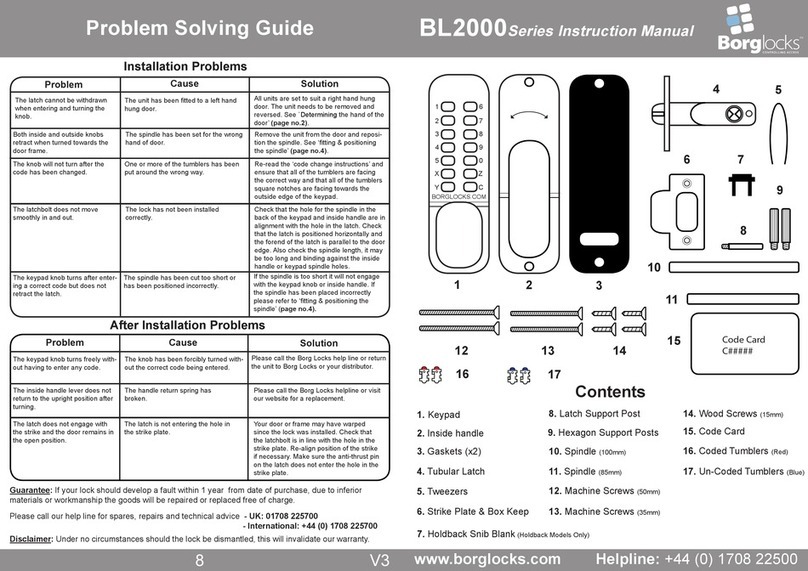
Borglocks
Borglocks BL2000 Series User manual

Borglocks
Borglocks BL5000 ECP User manual
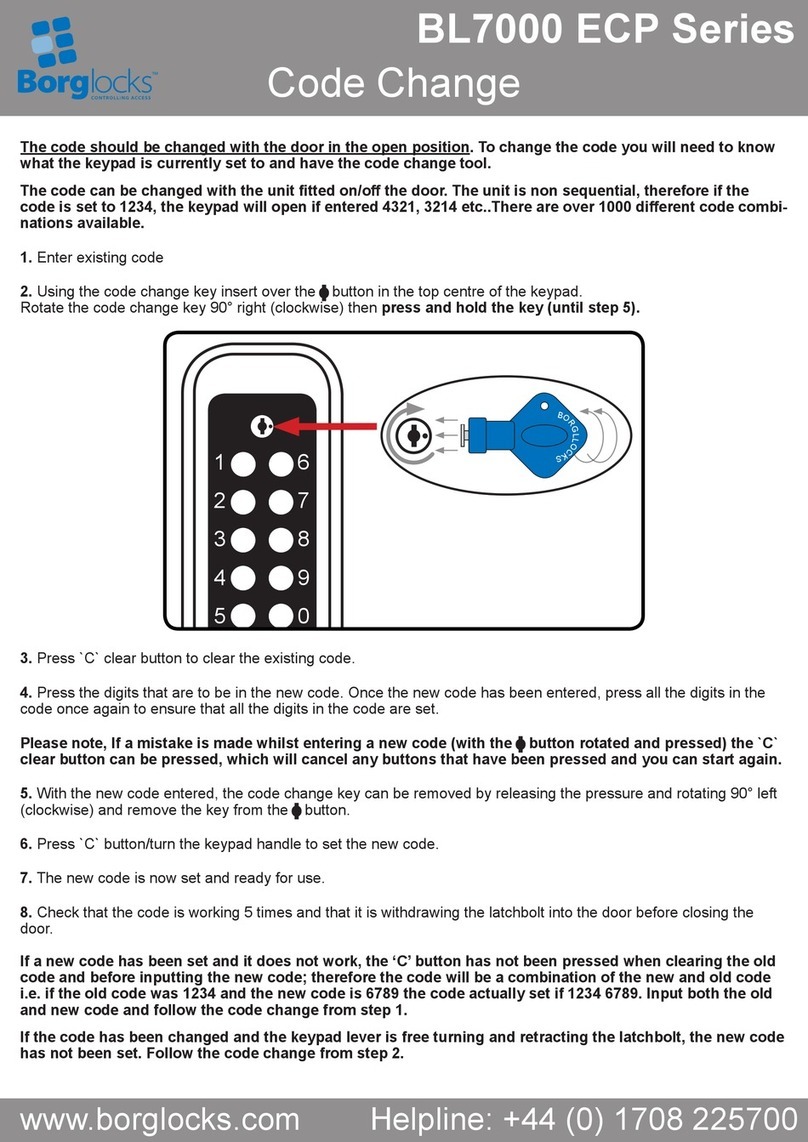
Borglocks
Borglocks BL7000 ECP Series Administrator guide
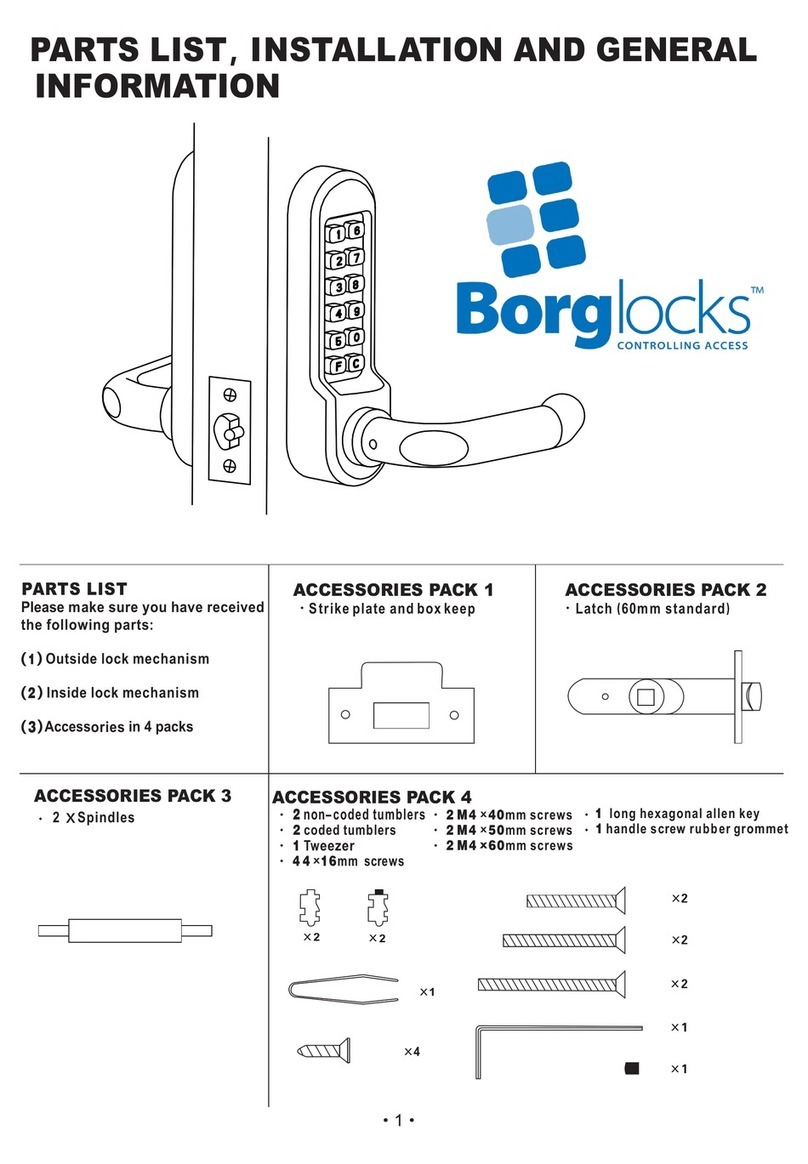
Borglocks
Borglocks BL5001 Service manual
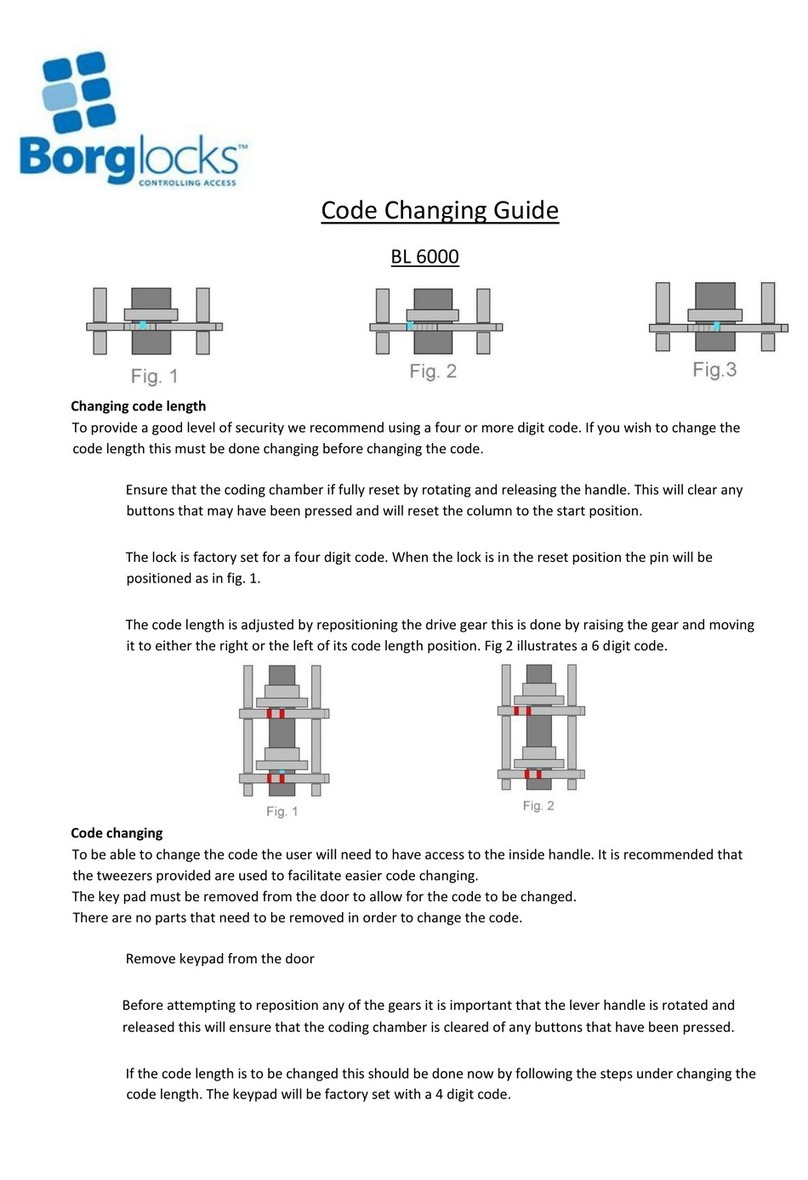
Borglocks
Borglocks BL 6000 Administrator guide
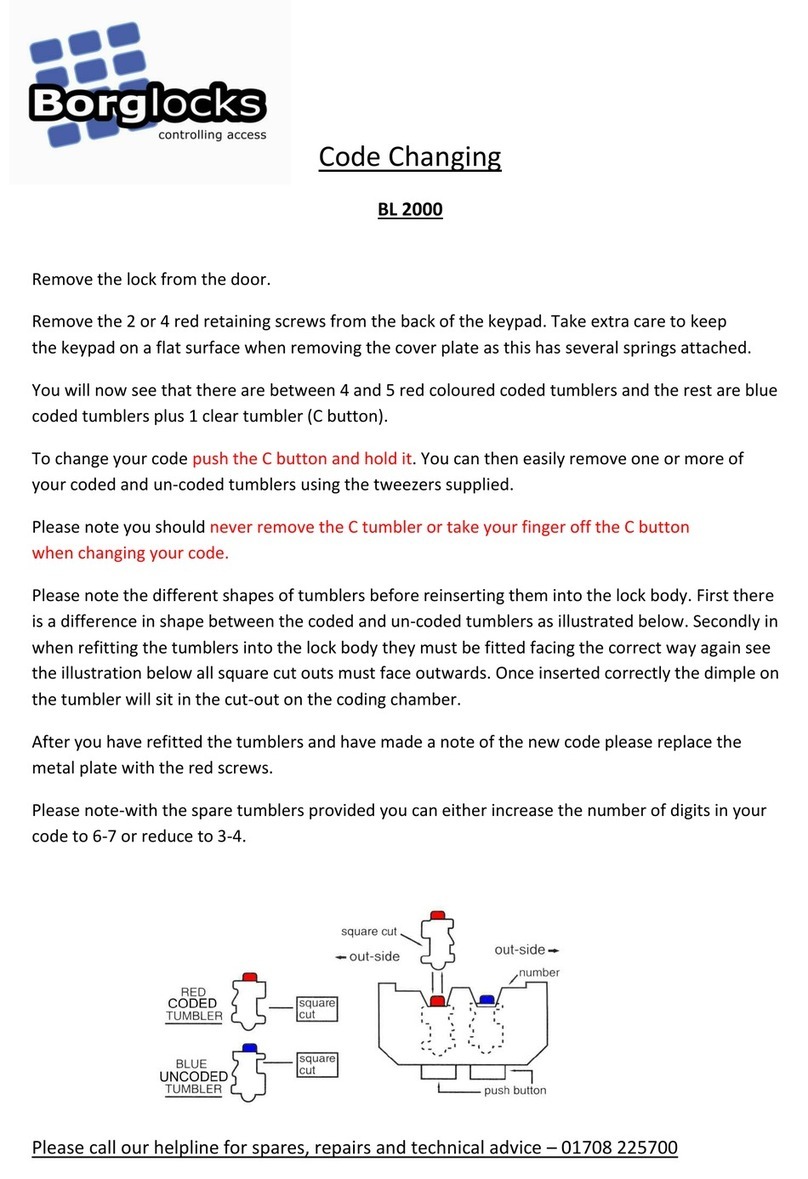
Borglocks
Borglocks BL 2000 User manual
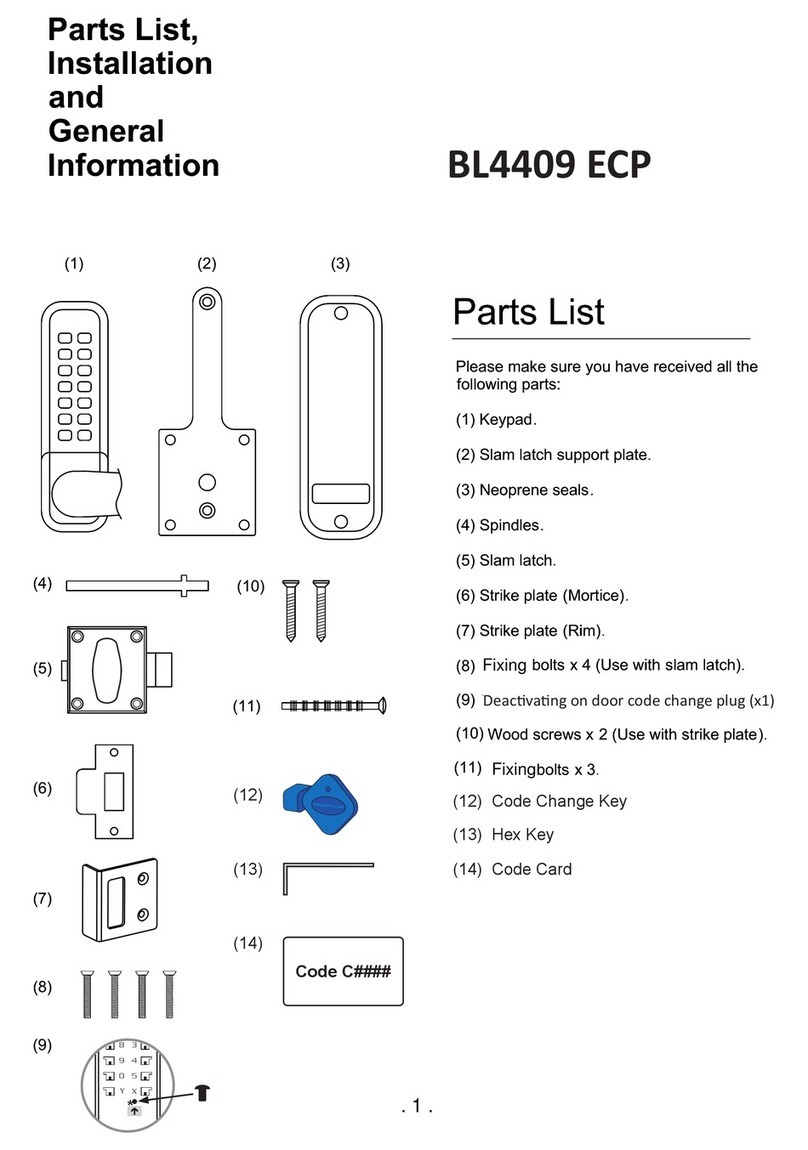
Borglocks
Borglocks BL4409 ECP Configuration guide
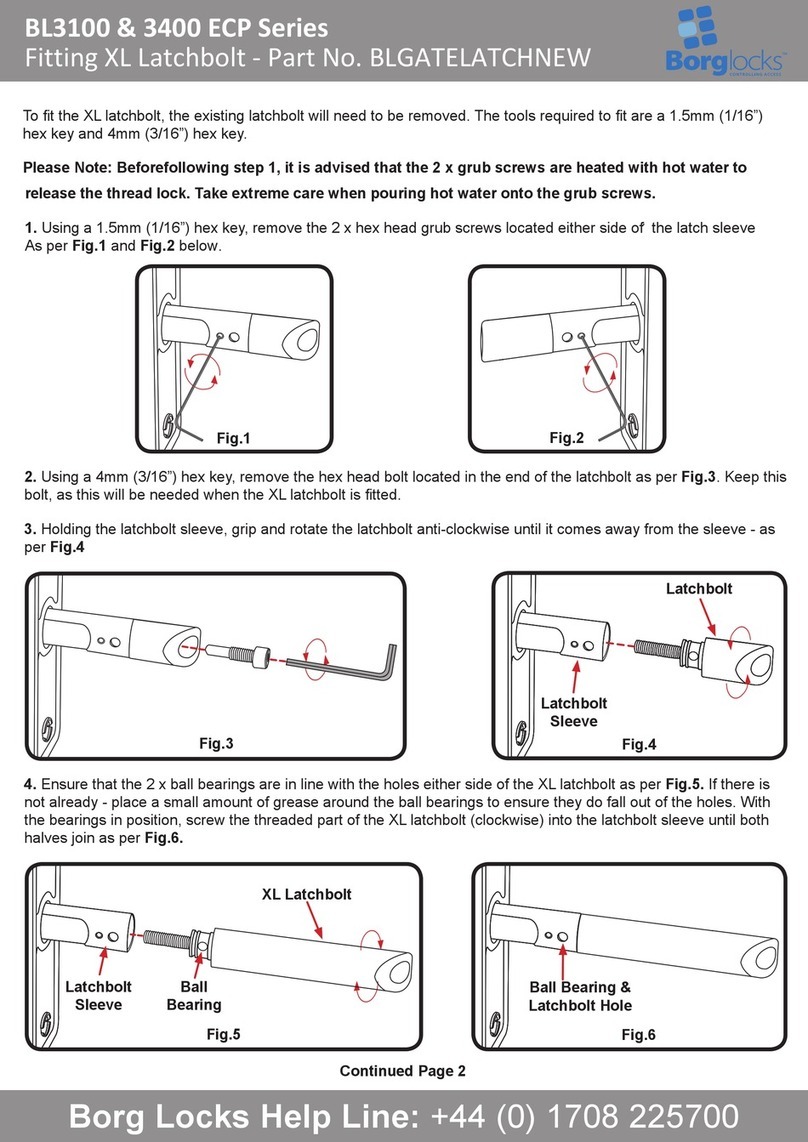
Borglocks
Borglocks BL3100 ECP Series User manual
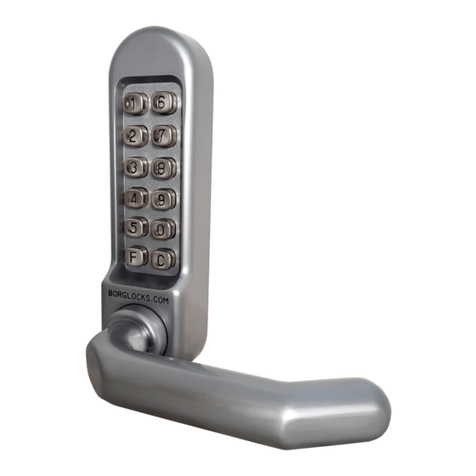
Borglocks
Borglocks BL5000 Configuration guide
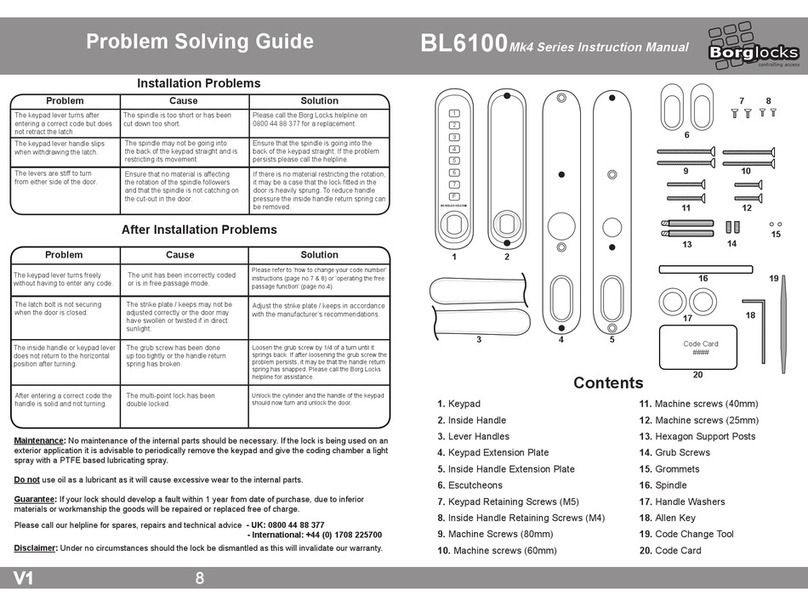
Borglocks
Borglocks BL6100Mk4 Series User manual
